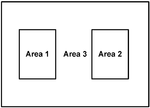abonic
Junior Member level 2
Dear all,
I'm doing the layout for a mixed-signal system on the P-SUB CMOS Process these days, there're two grounds AVSS & DVSS for Analog domain and Digital Domian.
Both Analog Core and Digital Core are enclosured by two dedicated Nwell Guarding Rings separetely, thus the Calibre LVS for both Analog Core & Digital Core pass with no error and no P-SUB warning.

However, when they are connected at the top level, there're 3 Areas on the P-SUB. Suppose, Area 1 is for AVSS, Area 2 is for DVSS, where should the rest part of the P-SUB (Area 3, actually enclosured by the Nwell strip of the PAD Ring) be connected so as to achieve a good noise-immunity performance.
I suppose it is a common issue in the mixed-signal layout design, which has a sophisiticated solution, could anybody help
Thank you!
I'm doing the layout for a mixed-signal system on the P-SUB CMOS Process these days, there're two grounds AVSS & DVSS for Analog domain and Digital Domian.
Both Analog Core and Digital Core are enclosured by two dedicated Nwell Guarding Rings separetely, thus the Calibre LVS for both Analog Core & Digital Core pass with no error and no P-SUB warning.

However, when they are connected at the top level, there're 3 Areas on the P-SUB. Suppose, Area 1 is for AVSS, Area 2 is for DVSS, where should the rest part of the P-SUB (Area 3, actually enclosured by the Nwell strip of the PAD Ring) be connected so as to achieve a good noise-immunity performance.
I suppose it is a common issue in the mixed-signal layout design, which has a sophisiticated solution, could anybody help
Thank you!